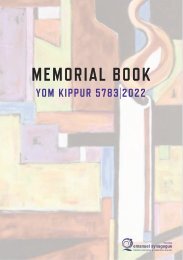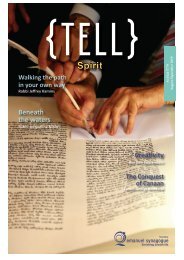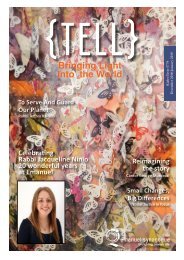TELL - December 2019 - February 2020
TELL - the magazine of Emanuel Synagogue, Sydney The Identity issue
TELL - the magazine of Emanuel Synagogue, Sydney
The Identity issue
Create successful ePaper yourself
Turn your PDF publications into a flip-book with our unique Google optimized e-Paper software.
{BLESSED IS THE FLAME}
By Reverend Sam Zwarenstein
Blessed is the match consumed in kindling flame. Blessed is the flame
that burns in the secret fastness of the heart… – Hannah Senesh
One of the mitzvot of Chanukah is
to place the candles in the window
each night, so that they can be seen
by those outside looking in, as well as
those inside, looking at, and enjoying
the light of the Chanukah candles.
We do so in order to share the beauty
of the Chanukah lights, but also, as
Noam Zion (Director of the Shalom
Hartman Institute’s Resource Centre
for Jewish Continuity) explains,
“It’s a public statement of what you
believe in. With Passover, the mitzvah
is to publicize the miracle to the
next generation of your family. With
Hanukkah, the mitzvah is to publicize
the miracle to the outside world.”
Why do we light candles on each of
the eight nights of Chanukah? The
candle lighting has many symbolic
messages. Firstly, it is a celebration
of the rededication of the altar in the
Temple, following the Maccabees’
successful conquest (circa 165 BCE)
over the Greeks, who had defiled
the Temple. Our narrative states
that upon regaining control of
the Temple, the Hasmoneans (the
dynasty that the Maccabees belonged
to) searched and found only one
cruse of oil, which was only sufficient
for one day. Yet, as we are told, it
lasted eight days. This explanation is
found in the Talmud, in Masechet
Shabbat 21b, when the Gemara asks:
“What is Chanukah?”.
The following two references to
the rededication are found in the
Apocrypha (those writings that were
not included in the Tanach, but
that still form part of our tradition).
“Then Judah and his brothers and
all the assembly of Israel determined
that every year at that season the days
of dedication of the altar should be
observed with gladness and joy for eight
days beginning with the twenty-fifth
day of Kislev”
(I Maccabees 4:59).
And from the second book of
Maccabees: “And they celebrated it
(the rededication) for eight days with
rejoicing, in the manner of the festival
of booths (Sukkot), remembering how
not long before, during the festival of
booths, they had been wandering in
the mountains and caves like wild
animals” (II Maccabees 10:6).
The second reference indicates that
we commemorate the rededication
for eight days, because we connect
the rededication of the Temple to the
celebration of the festival of Sukkot.
However, the festival of Sukkot is
only mandated for seven days: “You
shall observe it (Sukkot) as a festival
of God for seven days in the year; you
shall observe it in the seventh month as
a law for all time, throughout the ages”
(Leviticus 23:41). Why then does the
Book of Maccabees mention eight
days? Although the Torah states that
Sukkot is to be celebrated for seven
days, there is also a commandment
to observe the “eighth day” of Sukkot
as a festival on its own, which is
known as Sh’mini Atzeret. While
Sh’mini Atzeret is a separate holiday,
it is directly linked to and defined
by Sukkot. It is celebrated on what
would be the eighth day of Sukkot
(if it was an eight-day holiday).
Therefore, the reference to rejoicing
for eight days in the same manner
17















